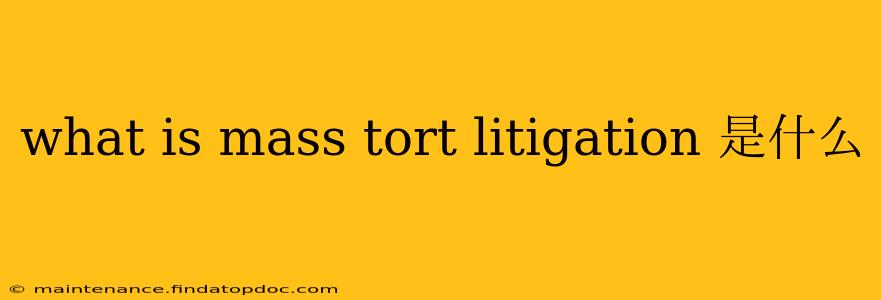What is Mass Tort Litigation? Understanding the Complexities of Multi-Party Lawsuits
Mass tort litigation refers to a complex type of civil lawsuit involving numerous plaintiffs who have all suffered similar injuries as a result of a defendant's actions. Unlike class-action lawsuits, which require plaintiffs to share common legal claims, mass tort cases involve individual claims with similar factual backgrounds. This means each plaintiff's case is unique, even though they all stem from the same underlying event or product. This distinction leads to significant differences in how these cases are handled.
The complexity of mass tort litigation arises from the sheer number of individual cases that need to be managed. Think of it as many smaller lawsuits bundled together, each requiring its own investigation, evidence gathering, and legal strategy. This necessitates significant resources and coordination, often involving multiple law firms and specialized teams of experts.
What are some examples of mass tort litigation?
Mass tort cases frequently arise from situations involving defective products, environmental disasters, or pharmaceutical side effects. Examples include:
-
Pharmaceutical Drug Litigation: Cases involving injuries caused by prescription drugs, such as Vioxx or Zantac. Thousands of individuals may file suit, each alleging specific harm resulting from the drug's use.
-
Toxic Exposure Cases: Lawsuits against companies responsible for polluting land or water sources, leading to illnesses among those living nearby. Asbestos litigation is a classic and long-running example.
-
Product Liability Cases: This often involves defective products that cause widespread injury, for example, defective airbags, faulty medical devices, or dangerous consumer goods.
-
Workplace Accidents: Large-scale accidents, such as industrial disasters, can lead to mass tort litigation on behalf of the injured workers.
What distinguishes mass tort litigation from class-action lawsuits?
This is a crucial point of clarification. While both involve multiple plaintiffs, they differ significantly in their structure and approach:
-
Class-Action Lawsuits: These involve a defined group of plaintiffs with identical legal claims. A single lawsuit represents the entire class, and a single judgment applies to all members.
-
Mass Tort Litigation: Each plaintiff files a separate lawsuit, even though they share a common underlying cause. This means individual trials or settlements are more common, leading to a potentially staggered and protracted legal process.
How are mass tort cases handled?
The sheer scale of these cases necessitates specialized management techniques. This often includes:
-
Multidistrict Litigation (MDL): A federal court procedure that consolidates similar cases from various jurisdictions into a single court for pretrial proceedings to enhance efficiency.
-
Settlement Negotiations: Given the complexity and expense of numerous trials, mass tort cases often involve extensive settlement negotiations. These can involve global settlements affecting all plaintiffs or individual settlements on a case-by-case basis.
-
Expert Witnesses: Because the scientific and technical aspects often play a large role, reliance on expert witnesses is crucial to establish liability and damages.
-
Coordination Among Law Firms: The massive scale requires collaboration among multiple law firms to handle the many individual cases effectively.
What are the challenges faced in mass tort litigation?
Mass tort litigation presents several significant challenges:
-
Managing a Large Number of Cases: The sheer volume of cases requires substantial resources and efficient management techniques.
-
Establishing Causation: Linking specific injuries to the defendant's actions can be complex, particularly when dealing with latent diseases or complex medical issues.
-
Scientific Evidence: The need for extensive scientific and medical evidence adds another layer of complexity and cost.
-
Ensuring Fair Compensation: Balancing the interests of individual plaintiffs and the defendant requires careful consideration and can lead to disputes over equitable compensation.
Is it possible to predict the outcome of mass tort litigation?
No, the outcome of mass tort litigation is highly unpredictable. Factors influencing the outcome include the strength of the evidence, the legal strategies employed, the judge's rulings, and the willingness of parties to settle. The length of the litigation process can also vary greatly.
In conclusion, understanding mass tort litigation requires grasping its intricacies and the significant differences between it and class-action lawsuits. It's a complex area of law demanding specialized expertise and significant resources, with outcomes often influenced by a multitude of unpredictable factors.
